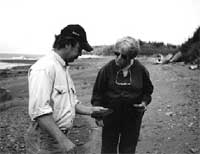
Promoting Cooperation to Maintain
and Enhance
Environmental Quality in the Gulf of Maine
Winter 2001
|
|
|
About |
|
Regular columns |
|
Archives |
A community’s gift to the Gulf of Maine
By Andi Rierden, Editor
The Cobequid-Chedabucto Fault System courses through Nova Scotia from the southern end of Cape Chignecto Provincial Park near Advocate Harbour in the Upper Bay of Fundy, then continues across the province and out to the Atlantic. The fault approximates the place where great landmasses collided 400 million years ago to form the supercontinent Pangea. When Pangea broke apart 300 million years later, large fragments formed the modern continents, such as North America.
At Red Rocks beach near the park’s entrance, the effects of the fault are revealed along the cliff escarpments in the form of crushed rocks. The red rhyolite cliff face at Spicer’s Cove traces back to the same epoch.
Evidence of the earth’s ancient geological and glacial evolution abounds in the park’s rock formations, sea stacks, sea caves, beaches and spits. It is also replete with more recent history, like the remains of lumbering settlements and sawmills and an entire village once inhabited by 400 people.
 Sea
Cave at Spicer's Cove. Photo: Andi Rierden.
Sea
Cave at Spicer's Cove. Photo: Andi Rierden.
Dominated by the western extension of the Cobequid Hills, Cape Chignecto splits the Upper Bay of Fundy into Chignecto Bay to the north and the Minas Basin to the south. The humid environment here supports a fog forest with rare mosses and lichens, alpine plants and valleys of red spruce. Peregrine falcons and sharp-shinned hawks hover above the high cliffs, and beginning in late summer, the beaches and inlets harbor large numbers of migratory shorebirds.
Covering 4,200 hectares (10,000 acres), including 29 kilometers (18 miles) of pristine coastline, the park joins Acadia National and Fundy National parks as a living monument to the northern Gulf of Maine’s natural heritage. And it is one of its best kept secrets.
Cape Chignecto, however, is a provincial park in name only. Opened in 1998, the park receives no provincial government money for day-to-day operations and supports itself through park revenues and grants. It employs five full-time local residents who take on everything from greeting visitors to clearing campsites and sculpting trails. Managed by a local board and the regional development authority, the park is solely community-operated.
On a recent visit, Maureen Mills and Bruce Morris, park employees, showed me around the new interpretive center, with walls of attractive panels depicting the park’s history and geological features. Before the park opened, both Mills and Morris completed a two-year training program in management, geology, natural history, survival skills and park hospitality. They helped landscape planners from the provincial Department of Natural Resources (DNR) create the parks trails, including a stunning 30-mile coastal route that takes up to five days to complete.
“All of us planted trees in the spring too,” said Mills, who raised seven children in Advocate Harbour where her husband was a fisherman.
Morris drove my friend and me to many of the sites through a tangle of rough access roads, remnants from decades of logging. Raised in Advocate Harbour, Morris left school at age 16 to log these woods for Scott Paper Timberlands, Cape Chignecto’s former owner.
“There isn’t a place in this park that hasn’t felt my footstep,” he said, while we hiked to a windy, cliff-side promontory called French Lookout. Down below lay Refugee Cove, where in 1755, a group of 300 Acadians fled after the British expelled them from Annapolis Royal.
To get to the cove from the visitor’s center requires a challenging overnight hike. In all, Morris and other park employees have cleared space for 25 walk-in and 47 backcountry hike-in campsites and two wilderness cabins. Making the transition from logger to park guardian, Morris said, has been a good change. “This land is a jewel in the Bay. Plus that, it provides jobs and helps to keep Advocate going.”
The idea to transform Cape Chignecto into a park was conceived nearly 20 years ago by a handful of residents intent on stopping the decline in the local logging and fishing industries and the resulting exodus of its young people. Ask Mills or Morris or just about anyone in the area how the park came to be, and the name Ruth Allen surfaces over and over.
As a local councilor for 20 years and lifelong volunteer, she campaigned hard to convince community members and the provincial government that a park would boost the economy and save a precious piece of the region’s heritage.
“Ruth Allen was the driving force behind this,” said Trevor Franker, a planner with DNR. “She pushed and pushed to get this done.”
Allen lives a few miles from the park in Port Greville where she grew up and worked for years as a schoolteacher. “It all seems so long ago,” she said, looking back to the park’s inception. “At the time we were just very interested in developing something that would bring tourists into the area and have them stay beyond just a scenic drive.” It was in the early 1980s and Allen and Waldon Rector, another local councilor, and other volunteers began looking to the property owned by Scott, the region’s largest employer, as the community’s possible salvation.
“We knew there was only so much lumber in there that could sustain the company and that they’d be looking to move on to other areas,” she said.
As members of a local economic development committee, Allen and Rector helped develop the first plan for a park at Cape Chignecto. It took years of pounding the pavement, but after many meetings, government officials agreed that the idea made good sense.
“Walt and I complimented each other, and wouldn’t take no for an answer,” Allen said. “If it meant a meeting in Halifax, which was 124 miles away, he’d often call me up and say, ‘they won’t come here, let’s go to Halifax’ and away we’d go."
In 1991, the Nova Scotia government acquired 15,000 acres from Scott and assigned an advisory board to come up with a plan to turn 10,000 acres into a park. But by 1994, economic times had changed and provincial budget cuts severed the funds for Cape Chignecto. Allen and her community were told that DNR would assist with the planning of the park, but other than that, the community was on its own.
“At that point, we had to do some real soul searching,” Allen said. “But we were so focused on trying to get jobs for our community and had already spread the word that there was going to be this big park. We just couldn’t back off. So we said ‘let’s get out there and get some money so we can get people working."
 Bruce
Morris and a park visitor examine fossils at Spicer's Cove. Photo: Andi
Rierden.
Bruce
Morris and a park visitor examine fossils at Spicer's Cove. Photo: Andi
Rierden.
Instead of working with one government agency, Allen said, they were now knocking on the doors of several, another long travail that eventually paid off. “We became a real nuisance to all these agencies. I think they all just saw how determined we were to get this done and figured they may as well get on board.”
In 1996, DNR signed a ten-year agreement with the Cape Chignecto Park Management Board, comprised of community groups, business operators and volunteers, and the Cumberland County Economic Development Association, to manage and operate the park. Their efforts have raised nearly $1.5 million dollars (US$930,000) from a long list of agencies including Human Resources and Development Canada, the Atlantic Canada Opportunities Agency, the Department of Economic Development and Tourism and the Nova Scotia Trails Destination Project.
Although the idea of the park has received broad community support, Allen said, it has not always been a smooth ride. As much as the management board tried to keep the community aware of the park’s plan, she said, through a newsletter, open houses and public meetings, some residents have resented the prohibitions placed on hunting and access to roads for all-terrain vehicles, or ATVs.
“Once the park opened, there was a backlash and some people realized there were restrictions and things were going to change,” said Allen, who was heading the management board at the time. “I was devastated because I thought we’d worked so hard to educate everybody. It caused a lot of heartache.”
In 2000, after years of serving as a regional councilor, Allen was voted out of office. “It’s possible that’s why I’m not on council anymore,” she said. “They just took their anger out on me.”
Nevertheless, the community is already reaping benefits from the park. Since Cape Chignecto opened, new businesses have sprouted such as bed and breakfast establishments and cabin rentals to serve the growing tourist trade. The local restaurant and convenience store have also expanded. Last year, more than 2,300 people visited the park from Canada, the United States and 19 countries overseas.
“Overall, most people in the community are tremendously pleased,” said Tom Young, a natural resource planner, who was hired to create the park’s first management plan. He added, “There were 6,000 acres of coastal forest and a lot of it was in various stages of old growth that were going to be cleared. For a small community to initiate and preserve this ecosystem is quite an achievement.”
Waldon Rector died not long after the park opened, but was able to attend opening ceremonies. As for Allen, she no longer heads the park’s board but continues to keep a close eye on Cape Chignecto’s progress.
“I’ve been trying to take it easy and take a back seat,” she said. “But I doubt if I will for very long.” She said simply, that she was proud to be part of the park project, adding, “We should all be looking for more of these areas that can be protected in this way.”
Visit Cape Chignecto’s Web site at http://parks.gov.ns.ca/chignecto.htm